Jason Schneider
the Camera Collector
A Breed Apart: Leaf shutter 35s wth lenses faster than f/1.7!
Two are rare, two aren’t, and two are easy to find and quite affordable!
By Jason Schneider
During the “Golden Age of Rangefinder 35s” that peaked in the ‘60s, there were literally dozens of Japanese-made, non-interchangeable-lens 35mm rangefinder cameras fitted with fast normal (45-50mm) lenses in the f/1.7 to f/2 aperture range. All had leaf shutters, most featured range/viewfinders with parallax-compensating field frame lines, and many had built-in CdS-cell meters, providing non-TTL autoexposure and/or metered manual exposure. The reason this type of camera was able to flourish is that, at the time, it offered photo enthusiasts something akin to the Leica shooting experience at substantially lower cost, albeit without the ability to switch lenses.
Well, to paraphrase a hackneyed metaphor, “Nothing exceeds like excess,” so a handful of intrepid Japanese manufacturers decided to up the ante by offering leaf shutter 35mm rangefinder with even faster lenses, with apertures like f/1.4, f/1.5, and f/1.6. From a marketing perspective, this strategy was hardly a great success, but it resulted in some fascinating, if somewhat ponderous, cameras with outstanding performance parameters and impressive low light shooting capabilities.
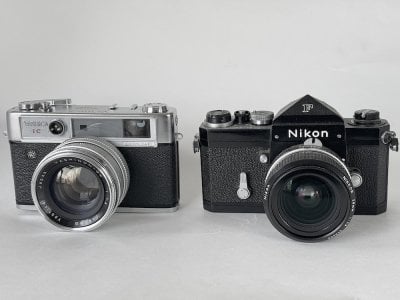
Yashica Lynx-14E with 45mm f/1.4 Yashinon-DX lens is big, roughly the same size as classic Nikon F with plain prism and 24mm f/2.8 Nikkor!
The Kallo 140 introduced by Kowa Optical Co. in 1959 certainly foreshadowed the trend that Mamiya, Yashica, and Konica were to embrace but technically it’s an interchangeable-lens camera with a leaf shutter behind the lens, like the Voigtlander Prominent I and II, and the Aires-35-V, which offered 50mm f/1.5 and 45mm f/1.5 normal lens options respectively. I call the Kallo 140 (which was, from 1960, rebranded as the Kowa 140) an “ILCINO,” an “interchangeable lens camera in name only.” Why? Because only two lenses other than the standard 50mm f/1.4 Prominar were ever made for it, the rare 85mm f/3.5 Prominar medium tele, and the virtually unobtainable 35mm f/2.8 Prominar wide-angle. Here’s the lowdown on this truly exotic beast:
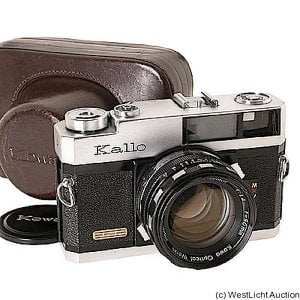
Kowa's audacious Kallo 140 of 1959 is shown here with interchangeable 50mm f/1.4 Prominar lens. Image courtesy WestLicht Auction
The exceptional and elusive Kallo 140 sported a 50mm f/1.4 Prominar lens, the fastest ever fitted to an interchangeable lens, leaf shutter rangefinder 35. The camera, which was introduced in July 1959, is a handsome, beautifully made, medium sized rangefinder 35 measuring 5-3/8 x 2-7/8 x 3-1/4 inches and weighing in at a hefty 2 pounds 1-1/4 ounces with standard, amber coated, 7-element, 4 group 50mm f/1.4 lens. Its viewfinder features a pair of true projected, parallax compensating yellow frame lines for the 50mm f/1.4 and 85mm f/3.5 Prominar lenses, with the outer edges of the finder defining the field (sans parallax compensation) for images shot with the 35mm f/2.8 Prominar. The leaf shutter that sits directly behind each mounted lens is a Seiko SLV with MX sync, and shutter speeds of 1-1/500 sec plus B. Both shutter speeds and aperture rings (to f/22) are locked together, but unlike other systems using the infamously inconvenient LVS system, uncoupling them is easy—just push the lefthand “ear” of the aperture ring as you turn it, and it won’t drag the shutter speed ring along with it. Brilliant!
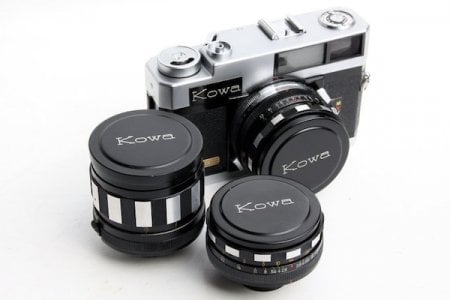
Kowa 140, rebadged c.1960 version of the Kallo 140, is shown here with 50mm f/1.4, 85mm f/3.5, and 35mm f/2.8 Prominar lenses.
To interchange lenses on the Kallo 140 you press a small spring-loaded tab on the underside of the lens, turn the knurled ring in the middle of the barrel 60 degrees counterclockwise, and lift the lens off. At the rear of the lens is a spring-loaded aperture coupling tab, and outboard of this tab there’s a chromed brass rangefinder coupling tab that simply moves in and out as you turn the focusing helical. Mount the lens on the Kallo’s beautifully machined 3-lobed external bayonet and the aperture tab enters an arc-shaped slot in which it couples to the aperture ring, and the rangefinder cam contacts a rounded end pin that couples the lens to the rangefinder system—simple, elegant, and ingenious. According to Japan Camera Industry Association (JCIA)] records the Kowa 140 sold for an initial price of 25,800 yen ($72 at the insanely favorable official exchange rate n 1959!), and its 50mm f/1.4 Prominar lens is a Sonnar type. Prices vary widely, but the Kowa Kallo 140 with standard lens has recently fetched $700 at auction and a complete 3-lens outfit in mint condition was offered at $2,800.
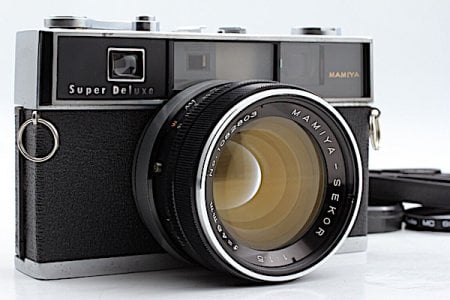
Mamiya Super Deluxe of 1964 with superb 48mm f/1.5 Mamiya-Sekor lens. It has CdS metering and a parallax compensating range/viewfinder.
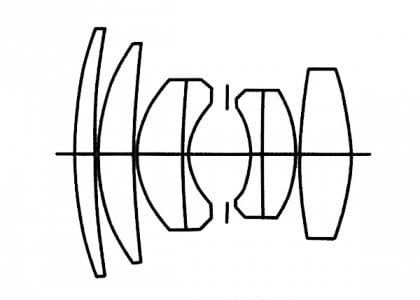
Optical diagram of the superb 7-element, 5-group 48mm f/1.5 Mamiya-Sekor lens. Design of 45mm f/1.6 on Konica Auto S1.6 is similar.
Mamiya Super Deluxe f/1.5: The Mamiya Super Deluxe is a series of high-end, noninterchangeable lens, leaf shutter rangefinder cameras introduced in 1964. The models with 48mm f/2 Mamiya-Kominar and 48mm f/1.7 Mamiya-Sekor lenses debuted in August; the version with the 48mm f/1.5 Mamiya-Sekor lens was announced in November. All three models have Copal-SVE leaf shutters with speeds of 1-1/500 sec plus B, MX sync via a PC connector, a built-in self-timer, and a cold shoe. They all feature big, bright, high magnification range/viewfinders with true projected, parallax-compensating frame lines, a CdS metering system with cell mounted above and to the side if the lens, and manual center-the-needle metering with indexes in the viewfinder and atop the camera. The meter was designed for 1.35v mercury cells and must be modified to give proper readings with current 1.5v batteries. Robustly constructed, and nicely finished in an assertively rectilinear post-deco style, all Mamiya Super Deluxe cameras feature excellent optics, and the 7-element, 5-group 48mm f/1.5 Mamiya-Sekor is capable of outstanding imaging performance. Models in pristine condition with the coveted 48mm f/1.5 lens go for about $400.00 to $550.00; examples fitted with the f/1.7 or f/2 lens are user-collector bargains that fetch around $150.00 apiece.
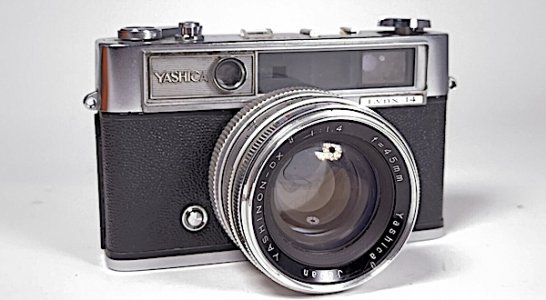
Yashica Lynx-14 of 1965 has magnificent 45mm f/1.4 Yashinon-DX lens and CdS metering system with center-the-needle exposure setting.
Yashica Lynx-14 and -14E: The original Yashica Lynx 1000 introduced in 1960 had a 45mm f/1.8 Yashinon lens, a built-in selenium meter and a top shutter speed of 1/1000 sec, one stop faster than most other leaf shutters. In 1962, the Lynx 1000 was upgraded with a CdS cell metering system and dubbed the Lynx 5000. Three years later, in 1965, Yashica took the Lynx concept to an entirely new level, releasing the Yashica Lynx-14, sporting a humongous 45mm f/1.4 Yashinon-DX lens, a sophisticated high-performance 7-element, 5-group design that’s the fastest and one of the sharpest lenses ever offered on a noninterchangeable lens rangefinder 35, and dropped the top shutter speed to 1/500 sec. Finally, in 1968, the company brought forth the Yashica Lynx-14E (labeled IC to denote its integrated circuit), which has the same impressive f/1.4 lens, but features an upgraded CdS metering system with a more sensitive, higher voltage meter cell, and over/under indicator lights in place of the Lynx-14’s precise but less rugged center-the needle system. Both the Lynx-14 and -14E have the same great automatic parallax correcting range/viewfinder with "Magic Spot" rangefinder with bright orangey-yellow field frame lines and well-defined rangefinder patch. The Copal SVE shutter in both models has speeds of 1-1/500 sec plus B, a built-in self-timer, and MX sync, with X at any speed, very useful for outdoor fill light. There’s a PC socket on the right side near the top, but neither model has a hot shoe. Film speed settings range from ASA 10 to 800, and there’s a little sticker on the back to remind users to press the chrome button labeled “switch” (it’s on the lower right front of the -14E in shooting position) to turn on the exposure meter. The port for the CdS cell is on the upper part of front of the camera, next to the range/viewfinder windows, so exposures must be manually compensated when using filters, a minor inconvenience.
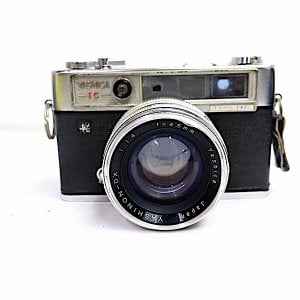
Yashica Lynx-14E of 1968 was the last of the breed. It retained the superb 45mm f/1.4 Yashinion-DX lens, replaced meter needle with lights.
Both the Yashica Lynx-14 and -14E were designed to take mercury batteries (the Lynx-14 took a single PX625; the Lynx-14AE took two PX640A cells) and must be converted to provide proper readings with current alkaline or silver oxide cells. Since both cameras are completely mechanical except for the meter, they remain fully operational sans battery power. The last Yashica Lynxes are awash in character and their 45mm f/1.4 Yashinon-DX lenses are superb, but these are big, hefty camera s(the Lynx-14 measures 5-1/2 x 3-3.8 x 6-15/16 inches and weighs in at 30 ounces). The good news: You can pick up a clean fully functional Yashica Lynx-14 or -14E for around $75.00 to $125.00—the lens alone is worth the price. Just make sure the seller offers full return/refund privileges.
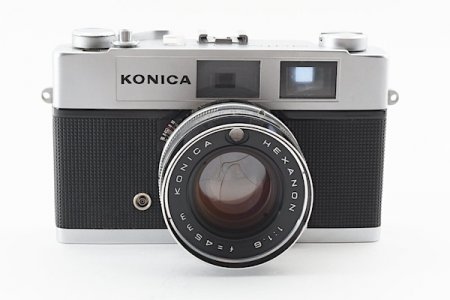
Konica Auto S1.6 released in 1967 is essentially a Konica Auto S2 with a faster lens, a superb 7-element, 5-group 45mm f/1.6 Hexanon.
Konica Auto S1.6: Unveiled in 1967, the Konica Auto S1.6 is basically a Konica Auto S2 with a 1/3-stop faster 45mm f/1.6 Hexanon lens, and the last member of the very popular Auto S series (the later Konica S3 was really the top-of-the-line Konica C35 series and dubbed “C35 FD” in Japan). The Konica Auto S1.6 is fitted with a more sophisticated 7-element, 5-group lens in a Copal-SVA 1-1/500 sec plus B shutter and has a built-in pull-out shade, and a hot shoe. It’s also the last Konica rangefinder camera of its era to offer full manual exposure plus the signature shutter priority autoexposure mode pioneered on the Konica Auto S models. It therefore remains useable even without battery power. The meter employs a CdS cell at the top of the lens I.D. ring, thus automatically compensating for mounted filters, reads out the camera-selected aperture in shutter priority AE with a needle and index in the viewfinder. It’s powered by a 1.35v PX625 mercury battery so it will require modification to work properly with current 1.5v alkaline or silver oxide cells. Its big, bright range/viewfinder has projected frame lines that not only provide automatic parallax compensation, but also correct for field frame size, the reduction in angular coverage as you focus closer—a unique capability in this class of camera. Solidly constructed, with excellent balance, ergonomics, and impressive on-film performance, the Konica Auto S1.6 is a great user camera that’s a phenomenal value at the current price range of $75.00 to $125.00 for a clean working example.
Two are rare, two aren’t, and two are easy to find and quite affordable!
By Jason Schneider
During the “Golden Age of Rangefinder 35s” that peaked in the ‘60s, there were literally dozens of Japanese-made, non-interchangeable-lens 35mm rangefinder cameras fitted with fast normal (45-50mm) lenses in the f/1.7 to f/2 aperture range. All had leaf shutters, most featured range/viewfinders with parallax-compensating field frame lines, and many had built-in CdS-cell meters, providing non-TTL autoexposure and/or metered manual exposure. The reason this type of camera was able to flourish is that, at the time, it offered photo enthusiasts something akin to the Leica shooting experience at substantially lower cost, albeit without the ability to switch lenses.
Well, to paraphrase a hackneyed metaphor, “Nothing exceeds like excess,” so a handful of intrepid Japanese manufacturers decided to up the ante by offering leaf shutter 35mm rangefinder with even faster lenses, with apertures like f/1.4, f/1.5, and f/1.6. From a marketing perspective, this strategy was hardly a great success, but it resulted in some fascinating, if somewhat ponderous, cameras with outstanding performance parameters and impressive low light shooting capabilities.

Yashica Lynx-14E with 45mm f/1.4 Yashinon-DX lens is big, roughly the same size as classic Nikon F with plain prism and 24mm f/2.8 Nikkor!
The Kallo 140 introduced by Kowa Optical Co. in 1959 certainly foreshadowed the trend that Mamiya, Yashica, and Konica were to embrace but technically it’s an interchangeable-lens camera with a leaf shutter behind the lens, like the Voigtlander Prominent I and II, and the Aires-35-V, which offered 50mm f/1.5 and 45mm f/1.5 normal lens options respectively. I call the Kallo 140 (which was, from 1960, rebranded as the Kowa 140) an “ILCINO,” an “interchangeable lens camera in name only.” Why? Because only two lenses other than the standard 50mm f/1.4 Prominar were ever made for it, the rare 85mm f/3.5 Prominar medium tele, and the virtually unobtainable 35mm f/2.8 Prominar wide-angle. Here’s the lowdown on this truly exotic beast:

Kowa's audacious Kallo 140 of 1959 is shown here with interchangeable 50mm f/1.4 Prominar lens. Image courtesy WestLicht Auction
The exceptional and elusive Kallo 140 sported a 50mm f/1.4 Prominar lens, the fastest ever fitted to an interchangeable lens, leaf shutter rangefinder 35. The camera, which was introduced in July 1959, is a handsome, beautifully made, medium sized rangefinder 35 measuring 5-3/8 x 2-7/8 x 3-1/4 inches and weighing in at a hefty 2 pounds 1-1/4 ounces with standard, amber coated, 7-element, 4 group 50mm f/1.4 lens. Its viewfinder features a pair of true projected, parallax compensating yellow frame lines for the 50mm f/1.4 and 85mm f/3.5 Prominar lenses, with the outer edges of the finder defining the field (sans parallax compensation) for images shot with the 35mm f/2.8 Prominar. The leaf shutter that sits directly behind each mounted lens is a Seiko SLV with MX sync, and shutter speeds of 1-1/500 sec plus B. Both shutter speeds and aperture rings (to f/22) are locked together, but unlike other systems using the infamously inconvenient LVS system, uncoupling them is easy—just push the lefthand “ear” of the aperture ring as you turn it, and it won’t drag the shutter speed ring along with it. Brilliant!

Kowa 140, rebadged c.1960 version of the Kallo 140, is shown here with 50mm f/1.4, 85mm f/3.5, and 35mm f/2.8 Prominar lenses.
To interchange lenses on the Kallo 140 you press a small spring-loaded tab on the underside of the lens, turn the knurled ring in the middle of the barrel 60 degrees counterclockwise, and lift the lens off. At the rear of the lens is a spring-loaded aperture coupling tab, and outboard of this tab there’s a chromed brass rangefinder coupling tab that simply moves in and out as you turn the focusing helical. Mount the lens on the Kallo’s beautifully machined 3-lobed external bayonet and the aperture tab enters an arc-shaped slot in which it couples to the aperture ring, and the rangefinder cam contacts a rounded end pin that couples the lens to the rangefinder system—simple, elegant, and ingenious. According to Japan Camera Industry Association (JCIA)] records the Kowa 140 sold for an initial price of 25,800 yen ($72 at the insanely favorable official exchange rate n 1959!), and its 50mm f/1.4 Prominar lens is a Sonnar type. Prices vary widely, but the Kowa Kallo 140 with standard lens has recently fetched $700 at auction and a complete 3-lens outfit in mint condition was offered at $2,800.

Mamiya Super Deluxe of 1964 with superb 48mm f/1.5 Mamiya-Sekor lens. It has CdS metering and a parallax compensating range/viewfinder.

Optical diagram of the superb 7-element, 5-group 48mm f/1.5 Mamiya-Sekor lens. Design of 45mm f/1.6 on Konica Auto S1.6 is similar.
Mamiya Super Deluxe f/1.5: The Mamiya Super Deluxe is a series of high-end, noninterchangeable lens, leaf shutter rangefinder cameras introduced in 1964. The models with 48mm f/2 Mamiya-Kominar and 48mm f/1.7 Mamiya-Sekor lenses debuted in August; the version with the 48mm f/1.5 Mamiya-Sekor lens was announced in November. All three models have Copal-SVE leaf shutters with speeds of 1-1/500 sec plus B, MX sync via a PC connector, a built-in self-timer, and a cold shoe. They all feature big, bright, high magnification range/viewfinders with true projected, parallax-compensating frame lines, a CdS metering system with cell mounted above and to the side if the lens, and manual center-the-needle metering with indexes in the viewfinder and atop the camera. The meter was designed for 1.35v mercury cells and must be modified to give proper readings with current 1.5v batteries. Robustly constructed, and nicely finished in an assertively rectilinear post-deco style, all Mamiya Super Deluxe cameras feature excellent optics, and the 7-element, 5-group 48mm f/1.5 Mamiya-Sekor is capable of outstanding imaging performance. Models in pristine condition with the coveted 48mm f/1.5 lens go for about $400.00 to $550.00; examples fitted with the f/1.7 or f/2 lens are user-collector bargains that fetch around $150.00 apiece.

Yashica Lynx-14 of 1965 has magnificent 45mm f/1.4 Yashinon-DX lens and CdS metering system with center-the-needle exposure setting.
Yashica Lynx-14 and -14E: The original Yashica Lynx 1000 introduced in 1960 had a 45mm f/1.8 Yashinon lens, a built-in selenium meter and a top shutter speed of 1/1000 sec, one stop faster than most other leaf shutters. In 1962, the Lynx 1000 was upgraded with a CdS cell metering system and dubbed the Lynx 5000. Three years later, in 1965, Yashica took the Lynx concept to an entirely new level, releasing the Yashica Lynx-14, sporting a humongous 45mm f/1.4 Yashinon-DX lens, a sophisticated high-performance 7-element, 5-group design that’s the fastest and one of the sharpest lenses ever offered on a noninterchangeable lens rangefinder 35, and dropped the top shutter speed to 1/500 sec. Finally, in 1968, the company brought forth the Yashica Lynx-14E (labeled IC to denote its integrated circuit), which has the same impressive f/1.4 lens, but features an upgraded CdS metering system with a more sensitive, higher voltage meter cell, and over/under indicator lights in place of the Lynx-14’s precise but less rugged center-the needle system. Both the Lynx-14 and -14E have the same great automatic parallax correcting range/viewfinder with "Magic Spot" rangefinder with bright orangey-yellow field frame lines and well-defined rangefinder patch. The Copal SVE shutter in both models has speeds of 1-1/500 sec plus B, a built-in self-timer, and MX sync, with X at any speed, very useful for outdoor fill light. There’s a PC socket on the right side near the top, but neither model has a hot shoe. Film speed settings range from ASA 10 to 800, and there’s a little sticker on the back to remind users to press the chrome button labeled “switch” (it’s on the lower right front of the -14E in shooting position) to turn on the exposure meter. The port for the CdS cell is on the upper part of front of the camera, next to the range/viewfinder windows, so exposures must be manually compensated when using filters, a minor inconvenience.

Yashica Lynx-14E of 1968 was the last of the breed. It retained the superb 45mm f/1.4 Yashinion-DX lens, replaced meter needle with lights.
Both the Yashica Lynx-14 and -14E were designed to take mercury batteries (the Lynx-14 took a single PX625; the Lynx-14AE took two PX640A cells) and must be converted to provide proper readings with current alkaline or silver oxide cells. Since both cameras are completely mechanical except for the meter, they remain fully operational sans battery power. The last Yashica Lynxes are awash in character and their 45mm f/1.4 Yashinon-DX lenses are superb, but these are big, hefty camera s(the Lynx-14 measures 5-1/2 x 3-3.8 x 6-15/16 inches and weighs in at 30 ounces). The good news: You can pick up a clean fully functional Yashica Lynx-14 or -14E for around $75.00 to $125.00—the lens alone is worth the price. Just make sure the seller offers full return/refund privileges.

Konica Auto S1.6 released in 1967 is essentially a Konica Auto S2 with a faster lens, a superb 7-element, 5-group 45mm f/1.6 Hexanon.
Konica Auto S1.6: Unveiled in 1967, the Konica Auto S1.6 is basically a Konica Auto S2 with a 1/3-stop faster 45mm f/1.6 Hexanon lens, and the last member of the very popular Auto S series (the later Konica S3 was really the top-of-the-line Konica C35 series and dubbed “C35 FD” in Japan). The Konica Auto S1.6 is fitted with a more sophisticated 7-element, 5-group lens in a Copal-SVA 1-1/500 sec plus B shutter and has a built-in pull-out shade, and a hot shoe. It’s also the last Konica rangefinder camera of its era to offer full manual exposure plus the signature shutter priority autoexposure mode pioneered on the Konica Auto S models. It therefore remains useable even without battery power. The meter employs a CdS cell at the top of the lens I.D. ring, thus automatically compensating for mounted filters, reads out the camera-selected aperture in shutter priority AE with a needle and index in the viewfinder. It’s powered by a 1.35v PX625 mercury battery so it will require modification to work properly with current 1.5v alkaline or silver oxide cells. Its big, bright range/viewfinder has projected frame lines that not only provide automatic parallax compensation, but also correct for field frame size, the reduction in angular coverage as you focus closer—a unique capability in this class of camera. Solidly constructed, with excellent balance, ergonomics, and impressive on-film performance, the Konica Auto S1.6 is a great user camera that’s a phenomenal value at the current price range of $75.00 to $125.00 for a clean working example.
Last edited:
DownUnder
Nikon Nomad
Many of these cameras are greatly underrated. Often they end up being dumped in charity shops and sold off for pittances.
Here I'm thinking Mamiya, Kowa, Konica. In the '80s I had a Konica C35 which gave me amazingly rock-sharp images, to the point where I at times had to 'soften' them with a Cokin diffuser when making my usual 5x7 work prints. Landscapes often benefit from not being too sharp. Engravings in prints are an acquired taste, which I never did acquire.
Leaf shutters are marvelous to work with, particularly for lighting up people pix in daylight. I learned this many decades ago when taking news photos with my Yashica D (and later my Rolleiflex 3.5E2) and a Metz electronic flash unit.
One shouldn't overlook the Kodak Retinas, which are (sort of) close relations to the ones the OP wrote about. I took two of the older ones to Bali with me in 1972 and got some memorable images out of them, mostly of dancers in Ubud. Being small they are unobtrusive and the subjects usually ignore them after a minute or so. Which results in more natural, unposed photos. I kept mine for many years but finally let them go about six years ago, to someone who is using them and greatly enjoying the more basic photo experience.
When I met my SO in Malaysia in 1997, we went exploring together in that photographically supremely interesting country with our respective cameras. One was an Olympus Trip 35. Some of the color negatives taken during that two-month journey were among the sharpest I've had the pleasure of printing. Even as B&W the mid-tones come out shining and the range of greys are truly astounding.
If one can accept and work with their limitations, those El Chapo shooters are good value and worth acquiring. They are also (usually) quite simple mechanically (not all, some), and the older ones being entirely mechanical can (usually) be used as manually without relying on their (usually deceased) meters.
Apologies for the overuse here of "usually" but the word serves my purpose, so...
Here I'm thinking Mamiya, Kowa, Konica. In the '80s I had a Konica C35 which gave me amazingly rock-sharp images, to the point where I at times had to 'soften' them with a Cokin diffuser when making my usual 5x7 work prints. Landscapes often benefit from not being too sharp. Engravings in prints are an acquired taste, which I never did acquire.
Leaf shutters are marvelous to work with, particularly for lighting up people pix in daylight. I learned this many decades ago when taking news photos with my Yashica D (and later my Rolleiflex 3.5E2) and a Metz electronic flash unit.
One shouldn't overlook the Kodak Retinas, which are (sort of) close relations to the ones the OP wrote about. I took two of the older ones to Bali with me in 1972 and got some memorable images out of them, mostly of dancers in Ubud. Being small they are unobtrusive and the subjects usually ignore them after a minute or so. Which results in more natural, unposed photos. I kept mine for many years but finally let them go about six years ago, to someone who is using them and greatly enjoying the more basic photo experience.
When I met my SO in Malaysia in 1997, we went exploring together in that photographically supremely interesting country with our respective cameras. One was an Olympus Trip 35. Some of the color negatives taken during that two-month journey were among the sharpest I've had the pleasure of printing. Even as B&W the mid-tones come out shining and the range of greys are truly astounding.
If one can accept and work with their limitations, those El Chapo shooters are good value and worth acquiring. They are also (usually) quite simple mechanically (not all, some), and the older ones being entirely mechanical can (usually) be used as manually without relying on their (usually deceased) meters.
Apologies for the overuse here of "usually" but the word serves my purpose, so...
Last edited:
Dralowid
Michael
Not strictly 'on topic' but was there not a leaf shutter 35mm SLR that had a 1.4 in its range of lenses? At first I thought Pentina but no, not that one.
hilltime
Well-known
I have a Kallo and Kowa 140 with the two other lenses, acquired some years ago after finding an original manual and thinking, this looks
like an interesting camera, especially with a 50mm/F1.4 standard lens. It took some time to "hunt down" the 35 and 85 lenses, but in a period of two weeks time, both sets appeared on Ebay and I had to have them! Eventually I kept the best of both and reauctioned the other set for a small profit and will have to say, have rarely ever seen them again, especially the 35mm. These Prominar optics I feel are quite underrated against the more common glass of the time, but have found them sharp and with nice contrast in the limited times I have used them.
Also bought the Aires 35-V in a package called the Correspondents Kit, which included the body with 4.5cm/F1.5 Coral, 35/3.2 Coral, and 100/3.5 Coral with filters and hoods all in a beautiful fitted leather case. A prized piece I have had for quite sometime, and again, the lenses are no slouches.
From what I have read, this camera and optics were so costly and well made, they came to late on the market with the increasing move to SLR's, that this model contributed heavily to the end of Aires as a camera company after producing many great cameras in the 50's.
PS Have a Yashica 14E, because I had to but have never put a roll of film through it. It's a beast of a P/S camera.
Again, another great article, Jason, on some rare and unique cameras.
like an interesting camera, especially with a 50mm/F1.4 standard lens. It took some time to "hunt down" the 35 and 85 lenses, but in a period of two weeks time, both sets appeared on Ebay and I had to have them! Eventually I kept the best of both and reauctioned the other set for a small profit and will have to say, have rarely ever seen them again, especially the 35mm. These Prominar optics I feel are quite underrated against the more common glass of the time, but have found them sharp and with nice contrast in the limited times I have used them.
Also bought the Aires 35-V in a package called the Correspondents Kit, which included the body with 4.5cm/F1.5 Coral, 35/3.2 Coral, and 100/3.5 Coral with filters and hoods all in a beautiful fitted leather case. A prized piece I have had for quite sometime, and again, the lenses are no slouches.
From what I have read, this camera and optics were so costly and well made, they came to late on the market with the increasing move to SLR's, that this model contributed heavily to the end of Aires as a camera company after producing many great cameras in the 50's.
PS Have a Yashica 14E, because I had to but have never put a roll of film through it. It's a beast of a P/S camera.
Again, another great article, Jason, on some rare and unique cameras.
das
Well-known
Wow, thanks, Jason. This was a great read!
Jason Schneider
the Camera Collector
I could be wrong but I can’t think of a leaf shutter SLR with an f/1.4 lens. If anyone out there can come up with one please let us know.Not strictly 'on topic' but was there not a leaf shutter 35mm SLR that had a 1.4 in its range of lenses? At first I thought Pentina but no, not that one.
Jason Schneider
the Camera Collector
Thanks for your kind words. You are lucky indeed to have Kallo 140 outfit—I suggest you run some film through it. As for Aires. they made excellent lenses, had ingenious designs, and an eye for style, but with the exception of Aires 6x6cm twin lens reflexes, Aires cameras are not paragons of reliability. Don’t ask me how I know-I have a Kallo and Kowa 140 with the two other lenses, acquired some years ago after finding an original manual and thinking, this looks
like an interesting camera, especially with a 50mm/F1.4 standard lens. It took some time to "hunt down" the 35 and 85 lenses, but in a period of two weeks time, both sets appeared on Ebay and I had to have them! Eventually I kept the best of both and reauctioned the other set for a small profit and will have to say, have rarely ever seen them again, especially the 35mm. These Prominar optics I feel are quite underrated against the more common glass of the time, but have found them sharp and with nice contrast in the limited times I have used them.
Also bought the Aires 35-V in a package called the Correspondents Kit, which included the body with 4.5cm/F1.5 Coral, 35/3.2 Coral, and 100/3.5 Coral with filters and hoods all in a beautiful fitted leather case. A prized piece I have had for quite sometime, and again, the lenses are no slouches.
From what I have read, this camera and optics were so costly and well made, they came to late on the market with the increasing move to SLR's, that this model contributed heavily to the end of Aires as a camera company after producing many great cameras in the 50's.
PS Have a Yashica 14E, because I had to but have never put a roll of film through it. It's a beast of a P/S camera.
Again, another great article, Jason, on some rare and unique cameras.
Dralowid
Michael
Forgot to say thanks to Jason for another great article delving into the backwoods of camera development and coming up with some surprising jewels!
ranger9
Well-known
Dang, the last thing I need is another 35mm film rangefinder camera, but along comes Schneider with an essay custom-made to trigger my acquisitiveness! One particularly interesting thing about this grouping: It should be possible for a person with strong completist instincts, determination, and a moderately high shopping budget to acquire the whole category... not that I'm going to try, mind you. I'm not. I'm not. Not not not...
Pioneer
Mentor
Thank you very much Jason for a great look at these interesting cameras. Fortunately I think I am safe for now as I am actually enjoying using my Pentax LX with the marvelous Pentax-A 50mm f1.2 lens. Especially as I am pretty sure that the LX, even with the larger f1.2 lens, is no larger and quite possibly smaller than these beauties. But it is still fun to dream!
KoNickon
Nick Merritt
I know the subject of Jason's piece is fixed lens cameras, but I think the Voigtlander Prominent with the 1.5 Nokton is worth noting. Remarkable camera, maybe not everyone's taste since the design is so different from the competition, but beautifully made and with great lenses. Mr. Gandy has a great writeup on it (which of course is what caused me to go get one...).
Jason Schneider
the Camera Collector
Thanks for your pungent observations. Acquiring the whole category would be a slam dunk except for the Kowa/Kallo 140 outfit—especially the 35mm f/2.8 Prominar. Good hunting!Dang, the last thing I need is another 35mm film rangefinder camera, but along comes Schneider with an essay custom-made to trigger my acquisitiveness! One particularly interesting thing about this grouping: It should be possible for a person with strong completist instincts, determination, and a moderately high shopping budget to acquire the whole category... not that I'm going to try, mind you. I'm not. I'm not. Not not not...
Jason Schneider
the Camera Collector
Agreed, the Pentax LX is a helluva camera, and the Pentax-A 50mm f/1.2 is outstanding, but rangefinder 35s with fast lenses have their charms. Try one-you might like it!Thank you very much Jason for a great look at these interesting cameras. Fortunately I think I am safe for now as I am actually enjoying using my Pentax LX with the marvelous Pentax-A 50mm f1.2 lens. Especially as I am pretty sure that the LX, even with the larger f1.2 lens, is no larger and quite possibly smaller than these beauties. But it is still fun to dream!
Jason Schneider
the Camera Collector
I am a huge Retina nerd, but late model Retina rangefinder cameras like the IIIc/IIIC have interchangeable lens components and no Retina ever had a lens faster than f/1.9.Many of these cameras are greatly underrated. Often they end up being dumped in charity shops and sold off for pittances.
Here I'm thinking Mamiya, Kowa, Konica. In the '80s I had a Konica C35 which gave me amazingly rock-sharp images, to the point where I at times had to 'soften' them with a Cokin diffuser when making my usual 5x7 work prints. Landscapes often benefit from not being too sharp. Engravings in prints are an acquired taste, which I never did acquire.
Leaf shutters are marvelous to work with, particularly for lighting up people pix in daylight. I learned this many decades ago when taking news photos with my Yashica D (and later my Rolleiflex 3.5E2) and a Metz electronic flash unit.
One shouldn't overlook the Kodak Retinas, which are (sort of) close relations to the ones the OP wrote about. I took two of the older ones to Bali with me in 1972 and got some memorable images out of them, mostly of dancers in Ubud. Being small they are unobtrusive and the subjects usually ignore them after a minute or so. Which results in more natural, unposed photos. I kept mine for many years but finally let them go about six years ago, to someone who is using them and greatly enjoying the more basic photo experience.
When I met my SO in Malaysia in 1997, we went exploring together in that photographically supremely interesting country with our respective cameras. One was an Olympus Trip 35. Some of the color negatives taken during that two-month journey were among the sharpest I've had the pleasure of printing. Even as B&W the mid-tones come out shining and the range of greys are truly astounding.
If one can accept and work with their limitations, those El Chapo shooters are good value and worth acquiring. They are also (usually) quite simple mechanically (not all, some), and the older ones being entirely mechanical can (usually) be used as manually without relying on their (usually deceased) meters.
Apologies for the overuse here of "usually" but the word serves my purpose, so...
Jason Schneider
the Camera Collector
Agreed. The Voigtlander Prominent I and II are probably the best interchangeable lens leaf shutter rangefinder 35s ever made and the 50mm f/1.5 Nokton and 50mm f/2 Ultron lenses are both outstanding.I know the subject of Jason's piece is fixed lens cameras, but I think the Voigtlander Prominent with the 1.5 Nokton is worth noting. Remarkable camera, maybe not everyone's taste since the design is so different from the competition, but beautifully made and with great lenses. Mr. Gandy has a great writeup on it (which of course is what caused me to go get one...).
xayraa33
rangefinder user and fancier
The German made Futura cameras also had some fast lenses for a leaf shutter 35mm camera, albeit interchangeable ones too.
Futura - Camera-wiki.org - The free camera encyclopedia
Futura - Camera-wiki.org - The free camera encyclopedia
Zuiko-logist
Well-known
I didn’t know about the Futura cameras. Thanks
Dralowid
Michael
In the past the Futura was grouped, in my 'collecting' mind, with the Lordomat. Of course the two companies are not associated. And then there are the Paxettes.
I doubt any of them could manage anything faster than f1.7 so irrelevant here.
I doubt any of them could manage anything faster than f1.7 so irrelevant here.
nhchen
Nathan
Futura did manage to produce a 50mm f1.5 and a very rare 70mm f1.5 interchangeable lenses for their cameras.In the past the Futura was grouped, in my 'collecting' mind, with the Lordomat. Of course the two companies are not associated. And then there are the Paxettes.
I doubt any of them could manage anything faster than f1.7 so irrelevant here.
Nathan
raid
Dad Photographer
Thank you for this interesting write-up, Jason.
I have a Lynx with the 40/1.4 lens, and I also hava Prominent I with the Nokton 50/1.5. Amedeo made me an adapter for the Nokton, and I can use RF focusing with any Leica and the Nokton.
I have a Lynx with the 40/1.4 lens, and I also hava Prominent I with the Nokton 50/1.5. Amedeo made me an adapter for the Nokton, and I can use RF focusing with any Leica and the Nokton.
Share:
-
This site uses cookies to help personalise content, tailor your experience and to keep you logged in if you register.
By continuing to use this site, you are consenting to our use of cookies.

